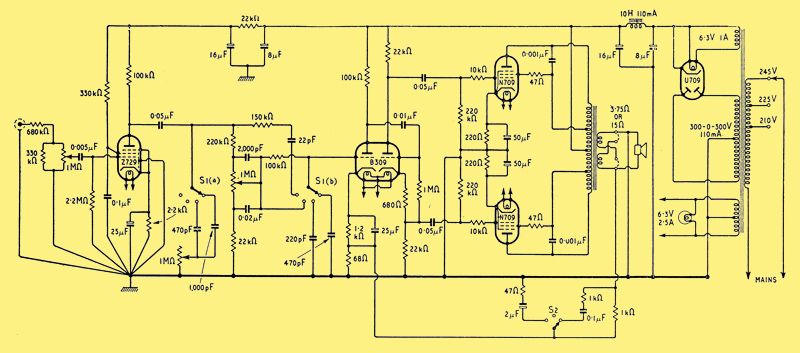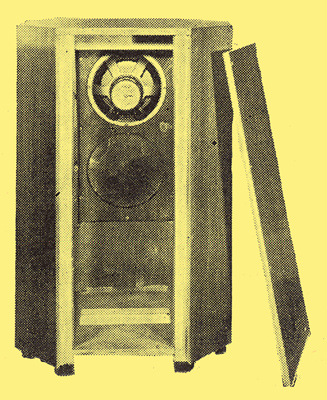|
Osram '912' Amplifier and GEC Metal-Cone Loudspeaker

The full circuit diagram
Circuit Description
Now that the GEC FR metal-cone loudspeaker is in quantity production, the makers have decided to issue a design for an amplifier which will ensure that its full capabilities are realized. This design will be published as a booklet (price 3s 6d), which will also give details of a recommended cabinet for the loudspeaker.
The circuit type number 912 indicates that the frequency range is 9 octaves (30Hz-16kHz) and that the power output is 12 watts. The first stage is a Z729 low-noise pentode, followed by a B309 double triode in which one triode acts as the second AF stage and the other as a phase splitter.
Two N709 pentodes in push-pull have the output load distributed between anodes and cathodes, thus giving a compromise between pentode and triode operation as far as efficiency and harmonic distortion are concerned.
Feedback is applied over the last three stages and can be modified by a switched RC network in the feedback loop to give a flat response or one with an approximately 5 dB level lift or drop from about 3,000 Hz upwards. This is described as a 'presence' control and when 'in' has the effect of transporting the listener to the front seats of the concert hall where the ratio of high to low frequencies is higher than, say, at the back of the hall, where the increased proportion of reverberation and high-frequency absorption tend to depress this ratio. The device is admittedly artificial but the effects are more realistic than those which would be obtained with normal sloping tone control characteristics. Normal tone control is, of course, provided (between the first and second stage) to cope with variations in recording and pickup characteristics. The FR metal-cone loudspeaker in addition to its low non-linearity distortion is capable of a very uniform and extended frequency response when housed in a suitable enclosure. A very rigid cabinet of octagonal section has been developed in which unwanted panel resonances are suppressed, only the single Helmhotz resonance being applied at or near the fundamental cone resonance to control the impedance rise and extend the low frequency response. The vent is situated in the centre of the cabinet, which is raised from the floor by four supports, the height of which tunes the acoustic resonance, since the air mass between the floor and base is in radial vibration. It is conceivable that, with this arrangement the resistive damping is increased. However this may be, the result is a remarkably smooth and full bass response down to 30 Hz which adds no trace of colouration to the reproduction of speech.

The cabinet designed by GEC for the metal-cone loudspeaker. The acoustic vent is in the base
|